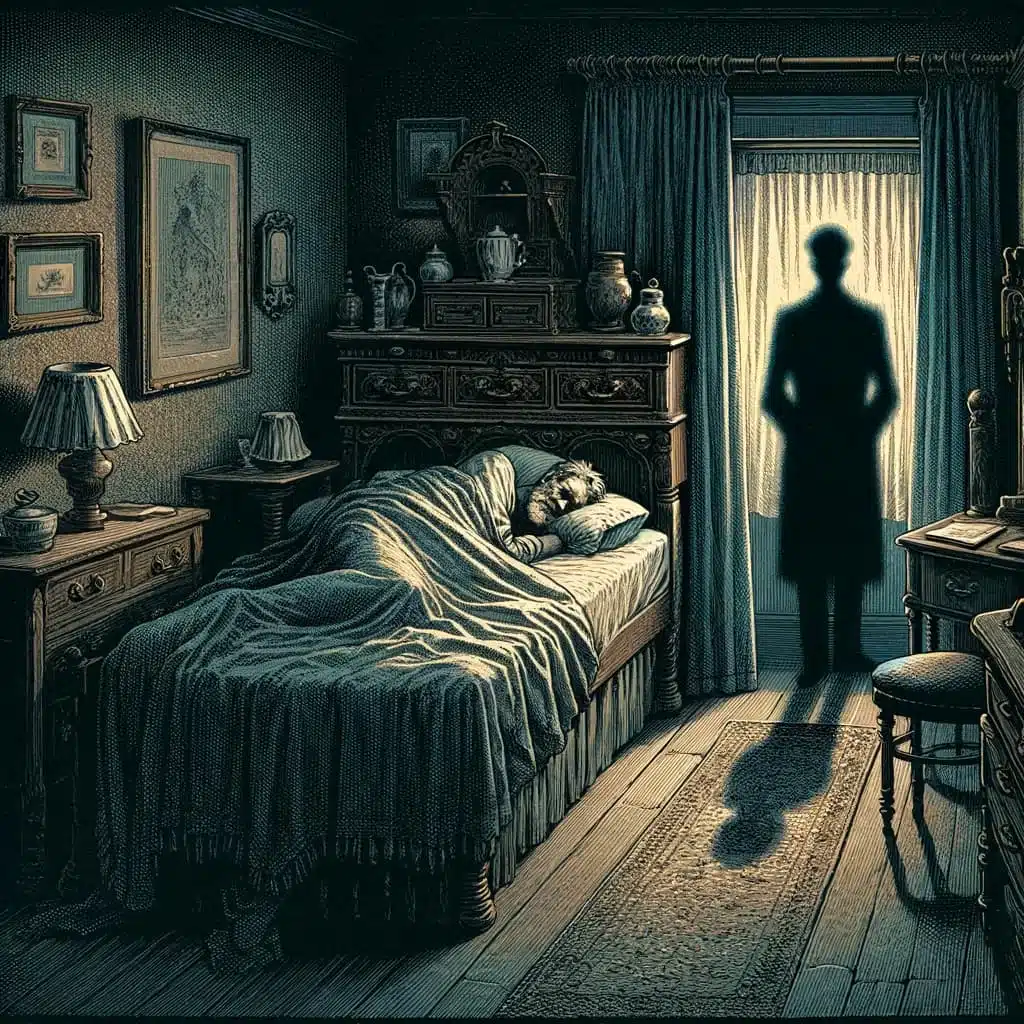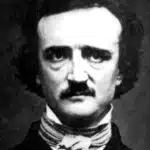“The Tell-Tale Heart” is a story by Edgar Allan Poe, published in 1843, that delves into the dark recesses of the human mind. The tale, narrated in the first person, follows a protagonist who insists on his sanity as he tells the events surrounding his cohabitation with an older man. The story centers on the narrator’s obsession with a particular physical trait of the older man, which triggers a series of tension-filled actions. As the plot unfolds, the reader is taken through a psychological journey that explores themes of guilt, paranoia, and the fine line between sanity and insanity. This tale is a classic example of Poe’s gothic and psychological horror style, where suspense and horror are built more through the atmosphere and character psychology than through supernatural elements or explicit violence.
Tabla de contenidos

Summary of “The Tell-Tale Heart” by Edgar Allan Poe
“The Tell-Tale Heart” is a short story by Edgar Allan Poe, a master of horror and mystery. This tale, initially published in 1843, focuses on the psychological torment and guilt of an unnamed narrator who seeks to justify his sanity while confessing to a horrific crime.
The tale begins with the protagonist insisting on his clarity and describing an illness that has sharpened his senses, especially his hearing. He becomes obsessed with the diseased eye of an older man with whom he lives, describing it as similar to that of a vulture. This obsession grows into an irrational desire to kill the older man to free himself from the gaze of that eye.
With meticulous premeditation and without ceasing to assert his complete sanity, the narrator describes how, for seven nights, he gently opens the room door where the older man sleeps to observe the eye with the help of a flashlight. However, his plan is thwarted because the eye remains closed each time. His hatred is for the eye, and it is imperative that it be open to encourage him to carry out his crime.
On the eighth night, the protagonist feels triumphant as he opens the door without waking the older man. However, an accidental sound awakens the older man, but he is unaware of the protagonist’s presence in the room due to his visual impairment. The protagonist remains still and expectant. After an hour of tense waiting, the older man falls asleep again, and the narrator decides to act. He notices that the eye is open and, in a fit of rage, murders the older man, suffocating him with a mattress.
After the murder, the narrator dismembers the corpse and hides the remains under the floor of the room. He prides himself on the cleanliness and cunning with which he has concealed the crime. However, his sense of triumph is disturbed when the police arrive, alerted by a neighbor who heard a scream. The narrator welcomes them confidently, explaining that he emitted the scream due to a nightmare and that the older man is out of town.
Convinced, the police officers sit down in the room where the corpse lies hidden. The narrator, initially calm, begins to feel increasingly uneasy and disturbed by a noise that only he seems to hear: the beating of the older man’s heart. This sound intensifies in his mind, driving him to despair and the brink of madness. Finally, overwhelmed by guilt and convinced that the cops are aware of his crime, he confesses and reveals the hiding place of the corpse.
The main characters in “The Tell-Tale Heart”
The Narrator: The central character and narrator of the tale is a man whose identity is never revealed. From the beginning, he is determined to prove his sanity despite confessing to a heinous crime. His development throughout the story is a gradual descent into madness, driven by his guilt and paranoia. Initially, he presents himself as someone extremely meticulous and proud of his cunning, describing in precise detail how he plans and executes the murder of the older man. However, this pride transmutes into a torturous obsession. The narrator’s transformation is significant: he begins as a proud and methodical individual. He ends up as a wholly unhinged and confused person, overwhelmed by guilt to the point of telling on himself.
The older man: The older man, the victim of the homicide, is described mainly through the narrator’s perception, which colors our understanding of him. The most prominent feature of the older man is his eye, which the protagonist compares to that of a vulture and which becomes the object of his obsession. Throughout the story, the older man is not developed as a character in any significant way; instead, he catalyzes the narrator’s madness. The older man’s presence is more symbolic than active, perhaps representing innocence, vulnerability, or an aspect of the narrator’s psyche that he wishes to destroy.
The police officers: Although they play a minor role, their arrival initiates the story’s climax. Their interaction with the narrator contrasts the protagonist’s apparent normalcy and inner turbulence. The police officers represent law and order, and their presence pushes the narrator into a state of paranoia that culminates in his confession. They are not developed as individual characters but function more as a narrative instrument to bring the plot to its conclusion.
The setting in which the story takes place
The setting is fundamental to creating the atmosphere of tension and psychological horror that characterizes the story. This is articulated mainly through three elements: the physical space, the psychological environment, and the use of time.
Physical space: The story takes place mainly in an old house, which is sparsely described in detail, contributing to a sense of vagueness and mystery. However, there are two areas that Poe highlights: the older man’s room and the room where the narrator and the police officers converse. The older man’s room, the scene of the murder, is described in terms of darkness and silence, elements that intensify the sense of fear and claustrophobia. The darkness is interrupted only by the thin line of light that the narrator filters through his flashlight, creating a sense of stalking and danger. In contrast, the room where the narrator interacts with the police officers is perceived as more normal, although the narrator’s growing internal tension erodes this normalcy.
Psychological environment: The psychological environment is even more critical than the physical. The tension and terror of the story are generated through the narration of the protagonist, whose disturbed and obsessive mind distorts reality. Fear, paranoia, and guilt are palpable throughout the tale, and Poe uses a first-person narrative to immerse the reader in the narrator’s deranged psyche. This psychological atmosphere is intensified by the description of the heartbeat, which, although a hallucination of the narrator, becomes an omnipresent element symbolizing his guilt and despair.
Use of Time: Handling time in the story contributes to the mood. The action takes place throughout eight nights, creating a sense of anticipation and suspense. The narrator meticulously details each night, building the tension until the climax on the eighth night. In addition, time seems to distort during the story, especially in the final scene, where the narrator’s perception of the heartbeat eternally prolongs the moments before his confession.

Writing techniques employed by Poe in “The Tell-Tale Heart”.
Numerous literary devices in “The Tell-Tale Heart” enrich the narrative and contribute significantly to the story’s overall effect. These devices include metaphors, similes, alliterations, and other stylistic elements, all of which play a vital role in creating an atmosphere of psychological terror and deepening the plot.
Metaphors and similes: Poe uses metaphors and similes to evoke vivid imagery and generate an unsettling atmosphere. A notable example is the comparison of the older man’s eye to that of a vulture, a metaphor that illustrates the narrator’s obsession with and horror of the eye. Such comparisons enrich the description and add to the story’s symbolism, with the eye possibly representing the truth or conscience the narrator wishes to eliminate.
Alliteration and rhythm: Alliteration and rhythm contribute to the story’s tension. Poe employs the repetition of sounds to create a rhythm that mimics the beating of the heart, especially toward the end of the story. This intensifies the reader’s sense of anguish and immersive experience, aligning the rhythm of the text with the narrator’s growing terror.
Dramatic Irony: Throughout the story, dramatic irony is employed. The reader knows the narrator’s madness and guilt despite his insistent claims of sanity and control. This gap between what the narrator perceives and the reality the reader understands adds a dimension of suspense and horror.
Personification: Poe personifies elements such as the narrator’s hearing, described as highly acute, almost as an independent entity with its own will. This amplifies the sense of paranoia and distortion of reality the narrator suffers.
Visual and auditory imagery: The story is full of detailed visual and auditory imagery that plays a crucial role in creating atmosphere. The description of the older man’s eye and the imaginary sound of the heartbeat are clear examples of how Poe uses these images to draw the reader into the narrator’s state of mind.
Play with time: Poe manipulates time effectively, stretching out tense moments and speeding up actions, contributing to disorientation and anxiety.
These literary devices are central to the impact of The Tell-Tale Heart. Through them, Poe tells a story and creates an experience that immerses the reader in a world of psychological terror, obsession, and guilt. Each stylistic element is carefully designed to heighten the tension and deepen the psychological complexity of the tale, demonstrating Poe’s mastery as a storyteller.
Narrative point of view: Who narrates the story in “The Tell-Tale Heart”?
Edgar Allan Poe’s “The Tell-Tale Heart” is narrated in the first person by the story’s protagonist, the perpetrator of the crime central to the plot. This narrative choice has profound implications for how the story is perceived and significantly affects the reader’s experience.
First-person: First-person narration provides an intimate and direct view into the narrator’s mind. The reader observes events from the narrator’s perspective and is immersed in their thoughts, emotions, and perceptions. This deep immersion into the narrator’s psyche is crucial to the psychological impact of the story.
Reliability of the narrator: Since the story is told from the protagonist’s perspective, the reader is confronted with the narrator’s reliability. The protagonist insists on his sanity at the story’s beginning despite his irrational actions and disturbed mental state. This tension between what the narrator presents and the reader interprets adds a layer of complexity and ambiguity to the narrative.
Empathy and understanding: first person allows the reader access to a more profound, albeit potentially biased, knowledge of the narrator’s motives and thoughts. While his actions are inexcusable, intimate exposure to his fears and obsessions can generate a sense of empathy or at least a more nuanced understanding of his character.
Heightened suspense and tension: The first-person point of view is critical to building suspense. The reader experiences the narrator’s growing paranoia and fear firsthand. This direct immersion makes the experience more intense and personal, increasing the story’s emotional impact.
Limited perspective: First-person narration also means that the reader only knows and understands what the narrator knows and perceives. This limitation in perspective can make the story more intriguing, as the reader must decipher what is real and what is the product of the narrator’s disturbed mind.
Poe’s choice of a first-person narrative in “The Tell-Tale Heart” is essential to its effectiveness as a tale of psychological horror. It allows for a deep and disturbing exploration of madness and guilt while challenging the reader to question the reality and reliability of what is narrated. This perspective gives the tale its unsettling character and ability to linger in the reader’s memory long after reading.
Central themes that Poe develops in “The Tell-Tale Heart.”
Guilt: One of the most prominent themes is guilt and its effect on the conscience. After committing the murder, the narrator is haunted by what he believes to be the beating of the older man’s heart, a palpable symbol of his guilt. This theme reflects the internal struggle between the desire to conceal a crime and the inability to escape one’s conscience.
Insanity and sanity: The story explores the fine line between insanity and sanity. The narrator insists on his sanity, although his actions and thoughts suggest otherwise. The narrative delves into the narrator’s disturbed psyche, examining how obsession and paranoia can lead to alienation.
Psychological horror: Unlike physical horror, the story focuses on psychological horror. Tension and fear are generated through the narrator’s mental deterioration and his distorted perception of reality, causing the reader to question what is real and what is not.
Obsession: The narrator’s obsession with the older man’s eye is a crucial plot driver. This obsession leads him to commit an irrational murder, demonstrating how a fixation can consume and destroy the mind and soul.
Identity and the self: The story also touches on identity. The first-person narration allows for an in-depth study of the self and identity of the narrator, whose perception of himself conflicts with his actions.
Isolation and loneliness: Although not explicit, the theme of isolation and loneliness permeates the story. The narrator seems to live in a closed world, interacting only with the older man and then with the police officers. This isolation may be a contributing factor to his mental deterioration.
The inevitability of fate: Finally, the story suggests the inevitability of fate. Despite his efforts to conceal his crime, the narrator eventually confesses, as if he cannot escape the fate he has forged.

Historical and cultural context
“The Tell-Tale Heart,” published in 1843, is a product of its time, reflecting various aspects of nineteenth-century America’s historical and cultural context. It is essential to consider several factors of the period to understand how these elements influence the tale:
Romantic and Gothic Era: Poe wrote during the height of Romanticism, a movement that emphasized emotions, nature, and individuality. Within this movement, Poe pioneered the Gothic subgenre in America, characterized by its focus on horror, the macabre, and the supernatural. “The Tell-Tale Heart” reflects these influences by exploring extreme mental states, its dark atmosphere, and including horror elements.
Fascination with the mind and psychology: The 19th century saw a growing interest in psychology and the human mind. This interest is reflected in the short story, which explores the psyche of a disturbed protagonist. Obsession, paranoia, and guilt are central themes that resonate with contemporary research on the mind and mental illness.
Literary influences: Poe was influenced by European Gothic literature, as well as the works of contemporary authors. His stories often occur in ambiguous and timeless settings, giving them a universal quality. However, Poe’s style and focus on psychological horror were innovative and reflected a shift toward a more internal, psychological exploration in literature.
Poe’s context: Poe’s personal experiences, including his struggles with alcoholism, poverty, and the loss of loved ones, profoundly influenced his writing. His works’ dark and often pessimistic tone reflects his turbulence and challenges.
Development of American literature: In Poe’s time, American literature was still in its formative stages, seeking a distinctive voice separate from European influences. Through his unique style and focus on universal themes, Poe contributed significantly to the evolution of a literary identity for America.
Conclusions
“The Tell-Tale Heart” by Edgar Allan Poe is a masterpiece of the American Gothic genre that stands out for its profound psychological study and oppressive atmosphere. The first-person narrative of the tale is an apt choice by Poe, as it allows the reader to immerse himself in the troubled mind of the narrator, making the reading experience intensely personal and disturbing. Poe’s use of language and literary devices intensifies the sense of terror and anxiety, leading the reader to question the reality of the events narrated and the sanity of the protagonist.
The theme of guilt and its effect on the conscience is handled with remarkable skill. The real or imagined heartbeat symbolizes the inescapable presence of guilt that haunts the narrator, suggesting a deeper interpretation of the story as a study of the psychological effects of crime and morality. The narrator’s obsession with the older man’s eye and his subsequent mental decline illustrates the fine line between sanity and insanity, a theme Poe explores with remarkable insight.
Poe’s ability to build suspense and terror through the psychological rather than the explicitly grotesque is a testament to his writing skill. The tale evokes horror through the protagonist’s actions and altered perception of reality, making “The Tell-Tale Heart” a unique and immersive reading experience.
“The Tell-Tale Heart” is ideal for readers looking for more than just a horror tale. It is perfect for those interested in character psychology and themes of guilt and morality. Fans of the Gothic genre and works that explore the limits of the human mind will find this tale a brilliant example of these themes. Likewise, admirers of 19th-century literature and the work of Edgar Allan Poe will thoroughly enjoy his rich narrative and oppressive atmosphere.

